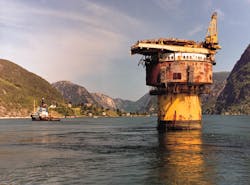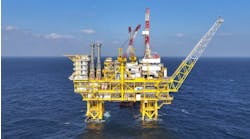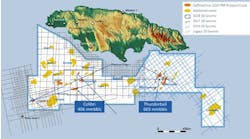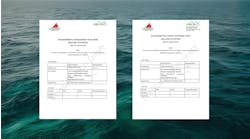Structure sling lifted, horizontally sliced
Jeremy Beckman
Editor, Europe
The Brent spar, resting in a Norwegian fjord, will be raised vertically using jacked cables and a lifting cradle. The hull is then cut into sections and skidded onto a barge for transportation. Spar slices are positioned for the quay extension, and finally, the concrete quay is laid on top.Fabrication yards may be the real winners following resolution of the Brent crude loading spar deadlock. Barring outrage from residents of coastal south-west Norway, the oil storage structure is destined for a new role at the Mekjarvik waterfront.
Out of the six short-listed disposal options, Shell Expro decided that Wood-GMC's was the best practicable environmental option. Also, according to Shell Expro's managing director Heinz Rothermund, the safety risks of this solution were no worse than for normal North Sea construction operations. On cost, this option beat the two main rivals hands down, mainly through avoiding a long-haul tow to the UK, as they had advocated.
Nevertheless, the final bill to Shell following the rumpus over its initial sea disposal decision will approach $75 million. That includes $16 million laid out on seminars, consultations, web-sites, CD-ROMs and so on - proof that dialogue does not pay.
While Shell lost revenue out of this exercise, chief prosecutor Greenpeace lost face. It was forced to retract certain lavish accusations of irresponsibility. DNV, the independent technical analyst for this project, concluded that there were no toxic chemicals concealed on the Spar - as Shell had vouchsafed - nor were there thousands of bbl onboard waiting to leak into the Atlantic.
Greenpeace said it would now press the next meeting of nations bordering the north-east Atlantic (OSPAR) in Lisbon this July to ban dumping at sea of all offshore installations, however large. If that victory is secured, numerous fabricators in northern Europe will join the fray for land-based platform disposal. Major yards including Barmac in northern Scotland had decommissioning investments hanging on the outcome of the Brent spar.
A blanket ban on deepsea disposals would have repercussions for the major oil companies. Of late they have offloaded their ageing North Sea installations to mature asset specialists from North America. But these scavengers may now think twice about short-term production extensions if faced with a $50 million-plus tab for full-scale removal.
The need to postpone that evil day could bring dividends for drillers. Shell Expro itself has no further abandonment outings looming until 2004, said decommissioning manager Eric Faulds. Even that, though, could be deferred until 2008, he added, with new infill drilling techniques emerging.
Whatever the OSPAR ministers may think, a blanket procedure should not be imposed on redundant North Sea installations, according to the UK Offshore Operators Association. Director-general James May commented: "Each structure is different and is built for a particular set of circumstances. It is unrealistic to have a generic solution for disposal of all offshore oil and gas installations. We need to maintain flexibility in the regulatory process so that the best solution can be reached for each structure."
Norway shifts stance
Another reason why Wood-GMC succeeded with their solution was a recent change of heart by the Norwegian government, sanctioning a final resting place in Norway. Since 1995, the spar had been moored in a fjord off Stavanger. Removal in these calm waters through cable-lift barges suddenly became more appealing than an operation involving a long-haul tow through choppy seas to the UK.The plan involves raising the spar vertically in the water using a lifting cable placed underneath the hull and other lifting cables connected by jacks mounted onboard several heavy lift barges. Total height of the spar, including its topsides, is 137 meters.
Rothermund said Shell was apprehensive of alternate proposals, which required the spar to be shifted to a horizontal position. An engineering review had revealed severe strains on the structure arising from the original installation, along with damage to the six storage tanks. That would have made a reverse pull-out operation hazardous, he claimed, "and explains why Shell keeps saying that the spar is unique."
The topsides, supported by a 17-meter diameter neck, will be removed and scrapped onshore at a Norwegian yard. As for the 29-meter diameter hull forming the bulk of the spar, this will be raised in stages allowing five ring sections to be cut, weighing at least 1,800 tons each, for subsequent transportation by barge to the mainland. Following rigorous cleaning of marine growth and wax treatment, these rings will be positioned by the existing quay at Mekjarvik and filled with ballast.
The quay extension will then be completed by placing a concrete slab on top of the rings.
If this plan is approved, the new quayside could be providing roll-on/roll-off ferry facilities from summer 1999. Faulds claimed the spar could gain a 100-year life extension in this new role. Stavanger Port Authority also gains through getting the materials free; normally, it would have paid $800,000 in new steel construction costs. As for the operator, Rothermund said, the main lesson of this drawn-out campaign was that "PR is everyone's responsibility in Shell - not just the PR department".
Copyright 1998 Oil & Gas Journal. All Rights Reserved.




